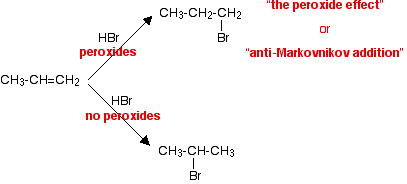|
HYDROGEN BROMIDE AND ALKENES: THE PEROXIDE EFFECT
This page gives you the facts and simple uncluttered mechanisms for the free radical addition of hydrogen bromide to alkenes - often known as the "peroxide effect". If you want the mechanisms explained to you in more detail, there is a link at the bottom of the page. Addition to symmetrical alkenes A symmetrical alkene is one like ethene where the groups at both ends of the carbon-carbon double bond are the same. The facts The reaction happens at room temperature in the presence of organic peroxides or some oxygen from the air. Alkenes react very slowly with oxygen to produce traces of organic peroxides - so the two possible conditions are equivalent to each other. The reaction is a simple addition of the hydrogen bromide. For example, with ethene:
With a symmetrical alkene you get exactly the same product in the absence of the organic peroxides or oxygen - but the mechanism is different. The mechanism Hydrogen halides (hydrogen chloride, hydrogen bromide and the rest) usually react with alkenes using an electrophilic addition mechanism. However, in the presence of organic peroxides, hydrogen bromide adds by a different mechanism. | ||
|
Note: If you are interested, you will find the electrophilic addition mechanism for the addition of hydrogen bromide and other hydrogen halides to alkenes if you follow this link. You may need to explore several pages in this section. Use the BACK button (or the HISTORY file or GO menu) on your browser to return to this page. | ||
|
With the organic peroxides present you get a free radical chain reaction. Chain initiation The chain is initiated by free radicals produced by an oxygen-oxygen bond in the organic peroxide breaking.
These free radicals extract a hydrogen atom from a hydrogen bromide molecule to produce bromine radicals.
Chain propagation A bromine radical joins to the ethene using one of the electrons in the pi bond. That creates a new radical with the single electron on the other carbon atom.
That radical reacts with another HBr molecule to produce bromoethane and another bromine radical to continue the process.
Chain termination Eventually two free radicals hit each other and produce a molecule of some sort. The process stops here because no new free radicals are formed. Addition to unsymmetrical alkenes An unsymmetrical alkene is one like propene where the groups at either end of the carbon-carbon double bond are different. The facts The reaction happens under the same conditions as with a symmetrical alkene, but there is a complication because the hydrogen and the bromine can add in two different ways. Which way they add depends on whether there are organic peroxides (or oxygen) present or not. 
Normally, when a molecule HX adds to a carbon-carbon double bond, the hydrogen becomes attached to the carbon with the more hydrogens on already. This is known as Markovnikov's Rule. Because the HBr adds on the "wrong way around " in the presence of organic peroxides, this is often known as the peroxide effect or anti-Markovnikov addition. In the absence of peroxides, hydrogen bromide adds to propene via an electrophilic addition mechanism. That gives the product predicted by Markovnikov's Rule. The free radical mechanism Chain initiation This is exactly the same as in the ethene case above.
Chain propagation When the bromine radical joins to the propene, it attaches so that a secondary radical is formed. This is more stable (and so easier to form) than the primary radical which would be formed if it attached to the other carbon atom.
That radical reacts with another HBr molecule to produce 1-bromopropane and another bromine radical to continue the process.
Chain termination Eventually two free radicals hit each other and produce a molecule of some sort. The process stops here because no new free radicals are formed. Why don't the other hydrogen halides behave in the same way? The reason that hydrogen bromide adds in an anti-Markovnikov fashion in the presence of organic peroxides is simply a question of reaction rates. The free radical mechanism is much faster than the alternative electrophilic addition mechanism. Both mechanisms happen, but most of the product is the one from the free radical mechanism because that is working faster. With the other hydrogen halides, the opposite is true. Hydrogen fluoride The hydrogen-fluorine bond is so strong that fluorine radicals aren't formed in the initiation step. Hydrogen chloride With hydrogen chloride, the second half of the propagation stage is very slow. If you do a bond enthalpy sum, you will find that the following reaction is endothermic.
This is due to the relatively high hydrogen-chlorine bond strength. Hydrogen iodide In this case, the first step of the propagation stage turns out to be endothermic and this slows the reaction down. Not enough energy is released when the weak carbon-iodine bond is formed.
In the case of hydrogen bromide, both steps of the propagation stage are exothermic.
© Jim Clark 2003 |
||